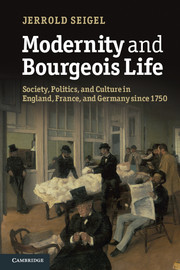 Modernity and Bourgeois Life
Modernity and Bourgeois Life Book contents
- Frontmatter
- Contents
- Illustrations
- Preface
- 1 Introduction: ends and means
- Part I Contours of modernity
- 3 Monarchical centralization, privilege, and conflict: France
- 4 Localism, state-building, and bürgerliche Gesellschaft: Germany
- 5 Modern industry, class, and party politics in nineteenth-century England
- 6 France and bourgeois France: from teleocracy to autonomy
- 7 One special path: modern industry, politics, and bourgeois life in Germany
- Part II Calculations and lifeworlds
- 9 Men and women
- 10 Bourgeois morals: from Victorianism to modern sexuality
- 11 Jews as bourgeois and network people
- Part III A culture of means
- 13 Bourgeois and others
- 14 Bourgeois life and the avant-garde
- 15 Conclusion
- Notes
- Index
13 - Bourgeois and others
Published online by Cambridge University Press: 05 June 2012
- Frontmatter
- Contents
- Illustrations
- Preface
- 1 Introduction: ends and means
- Part I Contours of modernity
- 3 Monarchical centralization, privilege, and conflict: France
- 4 Localism, state-building, and bürgerliche Gesellschaft: Germany
- 5 Modern industry, class, and party politics in nineteenth-century England
- 6 France and bourgeois France: from teleocracy to autonomy
- 7 One special path: modern industry, politics, and bourgeois life in Germany
- Part II Calculations and lifeworlds
- 9 Men and women
- 10 Bourgeois morals: from Victorianism to modern sexuality
- 11 Jews as bourgeois and network people
- Part III A culture of means
- 13 Bourgeois and others
- 14 Bourgeois life and the avant-garde
- 15 Conclusion
- Notes
- Index
Summary
Culture high and low
From the beginning the forms of cultural activity that found expression in the more public settings emerging at the end of the eighteenth century exhibited a characteristic set of tensions. Like cultural practices in practically every time and place, they aspired to broad, even universal, validity, treating the content they presented as capable of enhancing human life in general. It became apparent quickly that these assumptions would be undermined or frustrated by the social distinctions they sometimes sought to ignore. In the case of visual art the tension was already implicit in the ways public exhibits were set up during the late eighteenth century, but it became more salient and troubling when the Revolutionary Louvre opened in 1793.
Eighteenth-century public art spaces seldom offered unrestricted entry, and when they did the results often led the organizers to think again. The British Museum admitted only small groups and for a brief time, save for students and critics who were given privileged access on certain days. The Luxembourg gallery in the 1750s was in theory open to anyone, but publicity about it was directed to the higher ranks of society, those one writer described as “men of good sense … and good faith” who possessed “sensibility and quality of mind.” After Joseph II offered free access to his collection in the Upper Belvedere in 1770 he was met with sharp criticism from both artists and his own curators, who complained that a rowdy crowd interfered with giving serious attention to the works. When a Society of Arts set up the first public show of contemporary painting in London in 1760 the art dealers who ran it offered free and open admission, but the next year they decided to impose a fee, explaining that without one the room was “crowded and incommoded by the intrusion of great numbers whose stations and education made them no proper judges of statuary or painting and who were made idle and tumultuous by the opportunity of a show.”
- Type
- Chapter
- Information
- Modernity and Bourgeois LifeSociety, Politics, and Culture in England, France and Germany since 1750, pp. 450 - 481Publisher: Cambridge University PressPrint publication year: 2012
